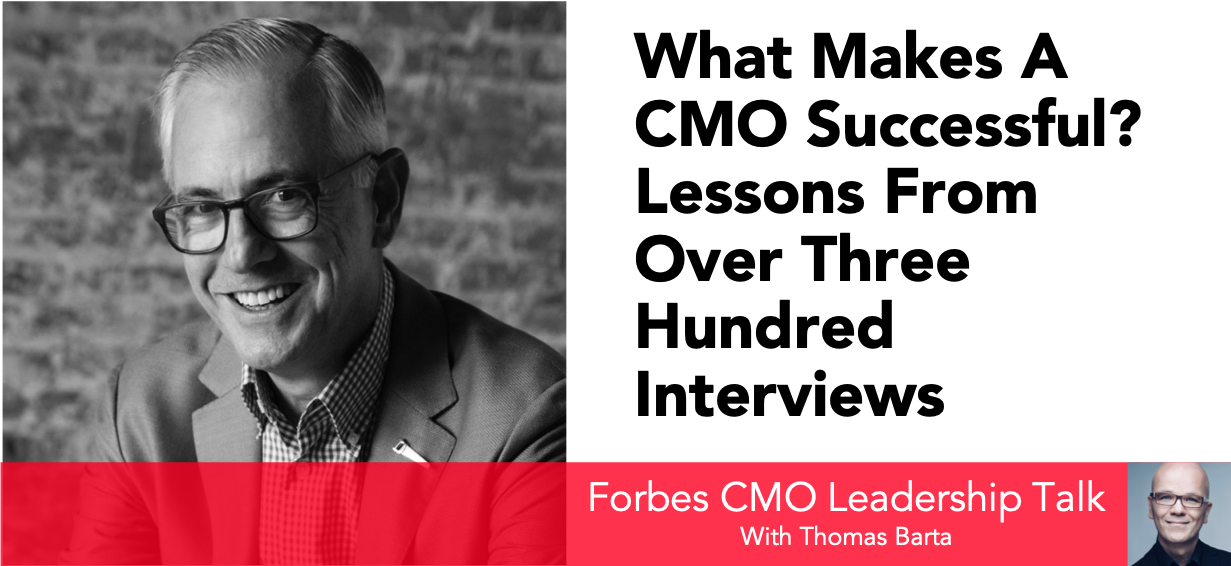Drew Neisser, author of the book The CMO’s Periodic Table and host of the CMO podcast Renegade Thinkers Unite interviewed over three hundred chief marketing officers. What did he learn?
I thought I’ll copy you in on this Forbes interview I recently did with Drew Neisser, author of the book The CMO’s Periodic Table and host of the CMO podcast Renegade Thinkers Unite.
Thomas Barta: Drew, you’ve interviewed over three hundred chief marketing officers for your podcast, articles and books. What characterizes the most successful CMOs?
Drew Neisser: The most successful CMOs are what I call “cool CATS,” which is short for “Courageous, Artful, Thoughtful and Scientific.” They have the courage to seek a unique if not distinctive position for the brand, and push to fix any shortcomings before relaunching. They are artful as leaders, building internal consensus around the strategy while giving credit to others. The thoughtfulness comes in how they communicate to employees, customers, and prospects—delivering value, not messages. And, finally, none of the above matters if they don’t bring a scientific approach to measurement, building a solid foundation of data for a new initiative, testing options, and identifying/tracking the metrics that matter.
Barta: No other C-suite member is more in the spotlight than the CMO. Why?
Neisser: Lots of reasons. First, marketing activity is generally more visible than, say, finance, HR or IT; so naturally it gets more than its fair share of attention. Second, there is an unfortunate “magic bullet” perception about marketing—that it can somehow solve all the ills of a company and do so with limited resources. Third, while a CIO would never think of suggesting how the CFO handle financial issues, that respectfulness doesn’t apply to the CMO—everyone thinks they’re a marketer and has no problem proffering guidance, informed or otherwise!
Barta: What, in your view, are the real marketing leadership challenges?
Neisser: First, expectation management. Most CMOs fail when they don’t align their plan with the expectations of the CEO , Board of Directors, and, in some cases, outside investors. Second, buying enough time up front to build a solid foundation for a bold new direction. There is so much pressure to show quick results that many skip the important steps, like customer research and employee alignment, thus dooming their new efforts to the scrap heap. To get this time, they need to negotiate up front with their CEO, who can provide the necessary air cover while a plan is built. “Ready! Fire! Aim!” rarely produces enduring results.
Barta: Why should anyone aspire to become a CMO today?
Neisser: If you know what you’re doing, it’s really an awesome job. Great CMOs have a dramatic impact on an organization, expressing the vision, evolving the culture, improving product/service performance, enhancing the customer experience, and accelerating growth. They are the agents of change, the ones who should know the customer the best and are able to push the organization into fresh frontiers. It’s neither easy nor fast, but that’s the thing about the great ones—they know what a unique brand looks like, how the pieces have to come together, and, most importantly, have the leadership skills to make it happen.
Barta: What’s the most remarkable CMO story you’ve come across?
Neisser: I love the story of Small Business Saturday, an enduring example of what we call marketing-as-service programs, which deliver meaningful value rather than just messaging. John Hayes, who was the CMO of American Express when this was launched back in 2010, rationalized its success noting, “We don’t do things just because they’re a trend; we do things because we think it’s the right thing to do for our customers.” Nine years later, among many other accolades, Small Business Saturday is the only program that has the unanimous support of both houses of the U.S. Congress.
Barta: Where do you see CMO influence going? Up or down?
Neisser: Hmm. I think that really depends on the skills of the CMO and the situation they’re in. The CMOs that know what they’re doing are finding themselves being given more and more responsibility. For example, Manny Rodriquez, the CMO of UC Health, a Colorado-based hospital network, after noticing customer experience issues, had this responsibility added to his portfolio. Others are absorbing corporate communications, internal communications, and/or e-commerce. In these cases, the key skill set evolves from marketing expertise to leadership expertise. On the flip side, CMO influence declines when they have a doubting CEO (i.e., uncertain that marketing can make a difference), which becomes a self-fulfilling prophecy.
Barta: In my research, I found that many CMOs aren’t fully aligned with their CEOs—leading to distrust. Do you observe the same? And what can be done?
Neisser: Absolutely. Successful CMOs know how to speak the CEO’s language (revenue, acquisition, retention, ROI) and are good at translating traditional marketing metrics into business factors. A CEO might say, “You can’t eat awareness,” and the CMO needs to be able to translate metrics like awareness into genuine business value (i.e., higher response rates, faster close rates, etc.). Another key issue here—as Darden’s Kim Whitler points out in her HBR article—is that CEOs and CMOs are misaligned from the beginning, with the CEO expecting one thing and the CMO better suited for another. This point is critical in that a CMO can’t be successful without the unwavering support of the CEO. Period. I recently interviewed Kathy Button Bell, who has been CMO at Emerson for 19 years. It’s no coincidence that she’s also had the same CEO for all of that time.
Barta: Many CMOs struggle with the digital transformation. What are the best ones doing right?
Neisser: Perhaps I’m drawn to the ones who get it. But I have to say, most of the CMOs I’ve talked to are fully engaged with digital transformation, at least when it comes to marketing technology. They’re getting the funding to build massive tech stacks, helping them to attract prospects, nurture leads, nurture customers, and, in some cases, close the sale. Ironically, I see the obsession with martech and digital tech as problematic, obfuscating the necessity of having a unique brand story. The optimization that is happening on a tactical level is often leading to a splintered story, one that doesn’t add up, especially when buying committees come together to make a large B2B purchase decision.
Barta: How relevant, in your view, is non-digital marketing today?
Neisser: This might surprise you, but I believe non-digital marketing is more important than ever. Digital spending surpassed TV spending for the first time in 2018, which is causing costs to go up and yields to decline. Savvy marketers zig when the crowd zags. Janine Pelosi, CMO of Zoom, the rapidly growing video conference service, shared with me how outdoor marketing (both in the U.S. and internationally) has had an outsized impact on their business. Similarly, Ann Lewnes, the well-regarded CMO of Adobe and a huge fan of digital marketing, at first questioned the huge investment Adobe made in events. But after witnessing their power, she is now a huge believer in this non-digital approach, especially when buttressed by digital communications.
Barta: Many CMOs complain they don’t have enough internal influence. What would you advise these CMOs?
Neisser: Influence is earned, not given. Too many CMOs tell their peers, here’s the plan. Instead, they are better served by co-developing with other departments, making them feel part of the process. Marketing is too complicated to succeed without full alignment of product, service, customer experience, human resources, IT and even security. Great CMOs have a knack for getting to know their peers, especially the ones who could impede success. For example, Bank of the West’s CMO Ben Stuart told me how he recognized from day one that he needed the support of HR for a rebranding to be successful; and as such, built a strong, mutually beneficial relationship.
Barta: When a CEO hires a new marketing leader, what should they look for?
Neisser: There are certain basics that every CMO should have, like a technical understanding of how marketing works and the role it can play in helping an organization achieve its goals. They don’t need to be an expert in the industry or every single aspect of marketing. But they do need to have the curiosity to learn what they don’t know and the smarts to hire a really good team to fill in the gaps. They need to have the intellectual honesty not to make changes just because they want to make their mark, and the courage to identify what must be fixed before marketing can be successful.
Barta: What’s the one piece of marketing leadership advice you’d give CMOS who are looking to make a real difference?
Neisser: It’s all about courage. You need to have the courage to ask your CEO for time, time to ask the tough questions, time to build a solid strategy, time to execute a program that is unique or at least distinctive in your category. You need the courage to aim really high, to push the organization to a bolder place: one that is defined both by what you do and don’t do. A strategy is only a strategy if it is crystal clear what you say no to.


